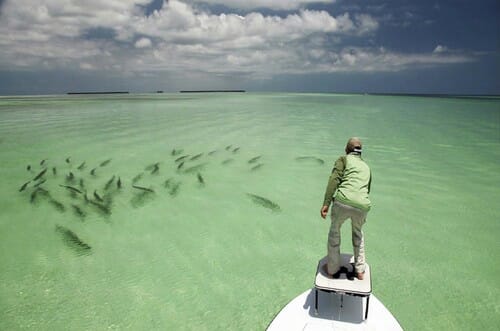People debate whether inshore fishing is better than offshore fishing. It really depends on your personal preference, as the two are very different.
Inshore fishing is any fishing that you do in waters that are up to 30 meters deep. In contrast, offshore fishing is any fishing where the waters are 30 meters or more deep.
It may appear to be a minor difference, but it is not. Each type is challenging in its own way, and each one has its own set of equipment requirements.
What is Inshore Fishing ?
Inshore fishing is any fishing you do in waters that are less than 30 meters deep. You normally stay within nine miles of the shoreline.
You might fish in estuaries, inter-coastal waterways, bays, saltwater flats, and more.
You will often hear anglers calling it by names such as fishing the skinny waters or fishing the flats. Most of the time, it refers to saltwater fishing.
What Equipment Is Needed for Inshore Fishing?
For inshore fishing, you can use smaller, faster inshore fishing boats. You can also use canoes and kayaks. In addition, people sometimes wade in the water or fish near docks.
The water is much calmer inshore, and you have less travel time because of your proximity to the shore.
Depending on whether you are going inshore vs offshore fishing the distance can be considerable.
Offshore fishing can require as much as two hours just to get out to the sea.
In addition, you do not need as much equipment. You can use lighter tackle, and people use both live and dead bait. There are a few different techniques you can use for inshore fishing, and you will use a GPS and a fish-tracking device.
Techniques for Inshore Fishing
You can use many different techniques for inshore fishing. You will choose one based on what type of fish you are targeting and what time of year it is.
The most common methods are still fishing and drifting. You can find a lot of different fish this way, and you can use a fly rod to catch Bonefish, Redfish, and Blacktip Sharks.
Another type of fishing is bottom fishing. People enjoy this method because they can catch Flounder and Bottom-Feeding Sharks.
In addition, people enjoy trolling for Snook, Barracuda, and other types of fish. Take a look at the following fighting techniques for inshore fishing:
- Still fishing
- Drifting
- Bottom fishing
- Trolling
- Popping
- Fishing the dock lights
- Sight casting
When you are inshore fishing, there are many different techniques you can use to catch a lot of different fish. Generally, you will want to fish near a place with underwater rocks, logs, wrecks, or docks where the game fish can hide.
What Type of Tackle to Use
Many people use an inshore spinning rod or a baitcasting rod with light or heavy tackle combined with an inshore saltwater spinning in a size 3000 to 4000.
Light tackle will allow you to target Speckled Trout, Pompano, Spanish Mackerel, small Redfish, and Flounder. Normally you will use a 6.5 to 7 foot rod with a fast-action tip and a 6 to 12 pound test line.
If you use heavy tackle, you can catch larger fish, including Sharks, Cobia, Tarpon, large Redfish, and Tripletail.
In this case, you will use a 7 to 7.5 foot long rod with a fast action tip and a 12 to 20 pound test line. You can use a test line up to 50 pounds for the biggest fish.
Most fly anglers will use a nine foot rod for inshore fishing, and they will have a reel that is made for saltwater fly fishing. If you are fly fishing, you will want to back your line with 200 to 300 yards of braided line.
Types of Inshore Fish
There are many great fish to catch when you go inshore fishing. They may be smaller than offshore fishing fish, but they are challenging to catch and put up a good fight.
You can find the following types of fish, depending on where you go:
- Tarpon
- Bonefish
- Snook
- Flounder
- Speckled Trout
- Permit
- Cobia
- Redfish
You can go inshore fishing any time of the year, even when there are seasonal changes, and you can find a variety of fish that are challenging to catch.
They may be smaller than offshore fish, but you can still find them up to 100 pounds or more but generally inshore tackle is light enough.

